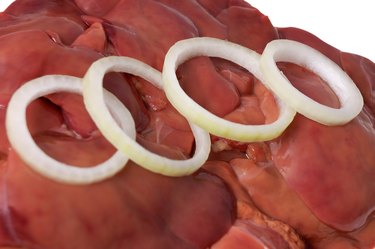
Iron deficiency is considered the most common nutritional deficiency in the world, according to the World Health Organization. Iron is an essential mineral found in all cells of the body and integral to a variety of processes. Iron deficiency is a condition in which too little iron is in the body, resulting in weakness and fatigue, among other symptoms. Chicken and beef liver contain high amounts of iron. They're good sources to meet daily iron intake recommendations.
Iron Content
Video of the Day
Chicken liver is one of the richest sources of iron; beef liver provides a good amount of iron. A 100g slice of pan-fried chicken liver contains 13mg iron, or approximately 72 percent daily value. A 100g slice of simmered chicken liver contains 11.6mg or 65 percent daily value, based upon a 2,000-calorie diet, according to "Calorie Lab." Raw chicken liver contains 9mg iron or 50 percent daily value per 100g. Raw beef, on the other hand, contains 4.9mg or 27 percent daily value of iron. A 68g slice of braised beef provides 4.4mg or 25 percent daily value of iron; an 81g slice of pan-fried beef provides 5mg or 28 percent daily value of iron, according to "Calorie Lab."
Video of the Day
Iron
Iron is a dietary mineral that plays a key role in a variety of bodily processes. A major function of iron is the role it plays in supporting the transport of oxygen in the body; nearly two-thirds of iron in the body is found in hemoglobin. Hemoglobin is a protein found in red blood cells that transports oxygen throughout the body. Iron is also required for certain chemical reactions in the body and the production of amino acids, neurotransmitters and hormones, according to Harvard Health Publications. The two forms of dietary iron include heme, which comes from animal sources, and nonheme, which comes from plant sources. Heme iron, the form found in chicken and beef liver, is more easily absorbed by the body as compared to nonheme iron.
Dietary Reference Intakes
The Food and Nutrition Board of the Institute of Medicine recommends 8mg iron per day for adults assigned male at birth and 18mg per day for adults assigned female at birth ages 19 to 50. Pregnant people need the highest amount of iron per day, with a recommendation of 27mg per day; lactating people need approximately 9mg to 10mg per day. Menstruating teens between 14 and 18 need 15mg per day.
Children ages 1 to 3 need 7mg per day, and those 4 to 8 need 10mg per day. The tolerable upper limit intake levels for iron are 40mg to 45mg iron per day. Toxicity can occur with high iron intake because it's not easily eliminated from the body. Keep iron supplements locked and away from children to prevent accidental iron toxicity, which can be fatal.
Deficiency
Iron deficiency, a common health problem around the world, most often leads to iron deficiency anemia or low levels of iron in the blood. It can be caused by low dietary intake, blood loss and iron absorption problems and cause symptoms such as fatigue, decreased performance and a weakened immune system. Pregnant and menstruating people as well as children are at the highest risk of developing iron deficiency, according to the Office of Dietary Supplements. Iron supplements are often prescribed for the treatment of iron deficiency.
Is this an emergency? If you are experiencing serious medical symptoms, please see the National Library of Medicine’s list of signs you need emergency medical attention or call 911.